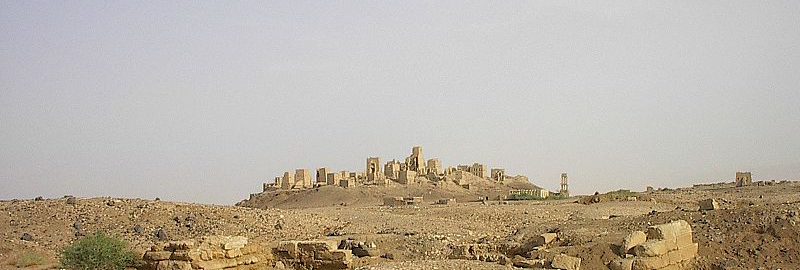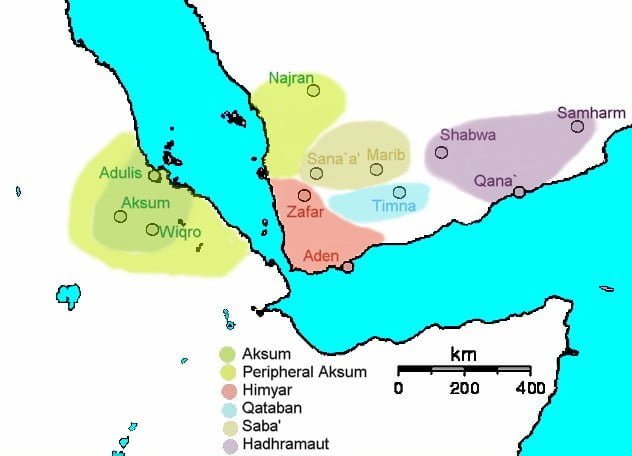Chapters
Any military and political activity by the Romans in the Arabian Peninsula is related to the actions taken by Emperor Octavian Augustus. The Roman legions, however, never conquered the territories of Arabia, which was largely dictated by the harsh climatic conditions and problems with food supply at a long distance.
Roman contacts with the Arabian Peninsula began with the establishment of trade cooperation with India. According to Strabo, a Greek geographer, after the conquest of Egypt in 30 BCE annually from the Egyptian port of Berenice Troglodytica (now Barnis) 120 Roman ships, which mostly “caught” the city of Eudaemon (now Aden) in the south of Arabia Felix (the name given by the Romans for the south of the Arabian Peninsula), on their way to India.
Sabaeans – the land of wealth
There were many tribes on the Arabian Peninsula, but the Sabeans were the strongest tribe. The Sabeans were descended from a people ruled in biblical times by a queen, whose name is not mentioned in the Bible, and who are called Bilkis or Makeda in extra-biblical sources. In the 1st century BCE, their country was an important trading centre through which all trade between the Mediterranean countries (especially Egypt) and India passed. The kingdom, naturally isolated from the world, was never conquered by either the Persians or the Romans. After joining Egypt to the Roman Empire, the conquest of the kingdom of Sheba became an important step in establishing direct contacts between Rome and the East.
The Greek historian and geographer Agatarchides described the Sabeans as follows:
[…] the Sabaeans, the largest of those in Arabia, possessing all kinds of wealth.
– Photius, Bibliotheca
Pliny the Elder, in turn, recalls:
The Sabaeans are the most wealthy, owing to the fertility of their forests in producing scents, their gold mines, their irrigated agricultural land and their production of honey and wax.
– Pliny the Elder, Natual history, 6.162
Diodorus Siculus, on the other hand, argued that the main city of the Sabeans was Sabei and that the wealth of the state exceeded any other treasure in the world. From information from Strabo, we know that the capital of the land was Mariaba and the people were ruled by a king who could not leave the palace.
But where did the idea of conquering the Arabian Peninsula come from? Strabo reports that Augustus’ intention was either to win over or subdue the Arabs. He hoped to either win rich friends or defeat wealthy enemies. Additionally, it should be emphasized that the Sabeans guarded the monopoly in the region, preventing merchants from Alexandria (including Roman) from entering the Bab el-Mandeb Strait (located between Africa and the Arabian Peninsula). Moreover, Augustus probably wanted to curb the arbitrariness of the pirates in the region, who obstructed the movement on the sea route.
Gallus’ expedition to the Arabian Peninsula
The Romans, wanting to increase their power and secure trade contacts, organized an expedition under the command of Gaius Aelius Gallus, the prefect in Egypt (praefectus aegypti) – in the years 26-24 BCE – in the times of the reign of Octavian Augustus, who temporarily introduced a Roman rule in the port of Eudaemon. Under his command, soldiers from Egypt were delegated and all meals were received from neighbouring peoples/allies.
The Romans also had a small military garrison in the Nabatean port of Leuke Kome (north of the present-day Jeddah port) to control the spice trade, especially incense and myrrh, two highly prized antiquities1. They could only be obtained from trees growing in the south of Arabia, Ethiopia or Somalia. Arab traders transported these products, the so-called They took the “incense route” from the south of the Arabian Peninsula and caravans to the shores of the Mediterranean Sea. It is assumed that the trail started in Shabwah in Hadhramaut in the very south of the Peninsula and ended in the city of Petra in Jordan. Strabo mentions that there was increased traffic on the main routes through the deserts: the army was marching and merchants were moving. Pliny the Elder, in turn, claims that the journey along the trail required 5-6 stops for camels, and the inhabitants of the Peninsula themselves earned a lot of wealth by transporting exotic goods to the Roman Empire.
The aforementioned prefect of Egypt, Gallus undertook to organize an expedition to Arabia Felix (“Happy Arabia”) and the city of Mariaba. They wrote about it in antiquity his friend Strabo (XVI, 780-783) and Cassius Dio (LIII, 29) and Pliny the Elder (Nat. Hist. VI, 32). In the beginning, it is worth mentioning that the name “Happy Arabia” given by the Romans to the southern areas of the Peninsula was due to the fact that the Romans considered these lands extremely rich and profitable.
Gallus’ ally was the King of Nabatea – Obodas III. The Nabataeans were to provide guides for the Romans and provide supplies early in the expedition. The Roman commander was sent by the ruler of Petra (in the strength of a thousand soldiers, under the command of a certain Sillaus) and the king of Judea – Herod the Great (in the strength of 500 men from the best guard). In total, the Roman army numbered about 10,000 soldiers, largely consisting of infantry. In addition, Gallus had 80 ships built and 130 transport ships built.
In 25 BCE Gallus left the port of Cleopatris (today’s Suez) on the Red Sea, leading an expedition to subjugate the Empire of the Kingdom of Sheba and capture its capital Mariaba on the southwestern tip of the Arabian Peninsula in today’s Yemen. The first destination of the expedition was the city of Leuke Kome, which belonged to the allied king Obodas III. The expedition took 14 days and as a result of storms, a large number of Roman units were sunk. Strabo blames Syllaus for this fact, who, in his opinion, intentionally concealed another, safer road – by land.
Bad luck, however, did not leave Gallus and his army, because in the city of Leuke Kome the legionaries were struck by a plague, which was to be caused by local water and herbs. Eventually, Gallus had to wait the summer and winter of 25 BCE in the city for his people to regain their strength.
When the Romans were ready, led by their guides, they headed south along the Red Sea. The road ran through the lands of Aretas, a relative of Rome’s ally – Obodas, which made it possible to better manage the expedition. However, the greatest nuisance for the Romans was the difficult terrain conditions, harsh climate and lack of water. Strabo reports that at that time they were deceived by Sillaus – therefore Gallus’ army needed almost 30 days to traverse the lands of Aretas. In the meantime, Iathrib (now Medina) and Mecca were seized without major problems.
Then the Romans entered a desert land inhabited by Nomads, and then reached the country of the Minean – Claudius Ptolemy claimed that their wealth was palm groves and trees. The next step was to capture the city of Negrana (present-day Nadjran) and fight the first major battle (six days’ march south of Negrana). According to Strabo’s message, Arab warriors, armed with double-edged axes, bows, slings, spears and swords, suffered a miserable defeat. It is said that almost 10,000 Arabs had to fall, and the Romans were to lose only two people.
Heading further south, the Romans conquered more cities: Negra, Amnestrum, Neska, Maguza, Tammakum and Labecyja. Pliny says that they were finally demolished.
At this point, there are discrepancies about the further journey south. According to Cassius Dio’s message, the Romans reached the southernmost city of Athrulla. Pliny the Elder, in turn, believes that Gallus conquered Mariaba and reached Caripeta. Strabo is of a different opinion, claiming that only Marsyba (Mariaba) has been achieved. August in turn – in his work Res Gestae – boasts that the legionaries reached the city of Mariaba.
However, following Strabo’s message, the Romans seized the city of Athula, left the garrison inside the walls, and the rest of the army headed towards the capital, Marsiabie. The siege also began there. However, after six days, Gallus was forced to withdraw from the walls, not only due to diseases and epidemics raging in the Roman army, but also due to large problems with the supply of the army and the stretching of the supply line.
Faced with the lack of regular deliveries, Gallus made the decision to retreat. The army set out on the road to Negrana and thence to Chaalla and Maloth. After a heavy 60-day march, the army reached the port of Egra, belonging to Obodas. From the port, the army went by ships to the Egyptian Myos Hormos and then to Alexandria. Strabo reports that as a result of direct clashes, only seven Roman soldiers died – due to the poor training of the Arabs. Certainly, however, the Romans suffered heavy losses during the murderous marches through the deserts.
The expedition ultimately ended in defeat, the invaders were repulsed, while the achievement of Gaius Aelius Gallus was that he moved the remnants of his troops back to Egypt enriching his knowledge of the geography of territories Arabia Felix, and so far never visited.
In the future, there was another clash between Romans and Arabs. In 1 BCE, the Roman navy destroyed the port of Adena for not respecting the terms of peace.
Establishment of the province of Arabia Petraea
The Nabataeans were a much more developed society than other Arab city-states, as evidenced by e.g. buildings even from before Roman times. The Nabataeans had a close relationship with the Romans from the time when the “sons of the Wolf” first travelled to the Southeast Mediterranean. Moreover, during the reign of Octavian Augustus (27 BCE – 14 CE), they were the client state of the Empire.
After the death of the Nabatean king Rabel II Soter in 106 CE, Trajan decided to annex Nabatea. Cornelius Palma, the governor of Syria, invaded the lands of the Nabataeans with virtually no resistance and took them on March 22, 106 CE. Nabatea was officially incorporated into the Roman Empire, creating the province of Arabia Petraea (the area of the present southern Jordan and northwestern Saudi Arabia) with the capital in Boston. Roman rule in these lands was confirmed by the construction of the road Via Nova Traiana from Aqaba to Bostra. However, the road not only connected these two cities, but also Petra and the “caravan route” connected with the port of Leuke Kome. Interestingly, the latest discoveries have confirmed that the Romans occupied the city of Mada’in Salih in the northwest of the Peninsula.
During the reign of Hadrian, there was a reduction in the conquered lands. This was to better adapt limes to defend Arabia Petraea from invasions. Septimius Sever, in turn, extended the province to include Leja and Jebel Drūz difficult areas south of Damascus. During this time, the Romans gained a strong ally in the form of the Ghassanids who moved from the territory of Mariaba to the area of southern Syria. The new Ghassanid territories became a buffer zone against other Bedouins penetrating Roman lands.
During the rule of Diocletian (284-305 CE) Arabia Petraea was expanded to include what is now Palestine.









